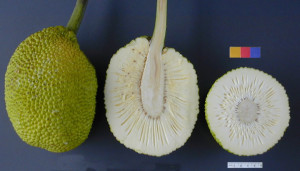By: Elizabeth Clark
Since childhood, most of us have heard our parents preach about the benefits of eating fruit. Fruits are, by definition, (usually) the edible reproductive body of a seed plant. And fruit is an essential part of a healthy diet, and the USDA MyPlate platform advocates that adults consume at least 2 cups of fruit a day. Because it is such an important part of our diet, new approaches to how it is used and consumed are being explored. Additionally, food and health industries are constantly searching for potential new “stars” that can join the fruit food group.
Recently, one “rising star” which has taken center stage and is receiving the world’s attention: breadfruit. Time Magazine and National Geographic have featured breadfruit in articles because of its potential to alleviate world hunger. Other headlines have dubbed breadfruit as “the Food of the Future,” quickly spreading its “super food” status to the masses. But what exactly is breadfruit?

What breadfruit looks like when you cut it open.
Breadfruit (Artocarpus altilis) has been a staple crop on Pacific islands for more than 3,000 years. British and French voyagers in the late 1700’s, brought a few seedless varieties westward to the Caribbean. Now, breadfruit is grown in tropical regions across the globe. Though it is a fruit, breadfruit is characteristically less like a fruit and more like a potato. If the “bread” part of its name conjured ideas of carbohydrates, well you wouldn’t be wrong. Breadfruit is a starchy, carbohydrate fruit equivalent to staple field crops such as rice, maize, potatoes, and sweet potatoes.
Despite all the starch, breadfruit definitely doesn’t lack in nutrients. A single cup of breadfruit has more potassium than three bananas. Other cultivars boast further health claims, like having high levels of fiber and beta-carotene; the latter of which prevents vitamin A deficiency and thus night blindness.

Breadfruit fried chips.
Besides being an untapped source of nutrition, breadfruits growing conditions make it an ideal candidate for feeding the world’s hungry. According to the Food and Agriculture Organization, tropical and subtropical regions, ripe for growing breadfruit, are host to the vast majority of the world’s poor and hungry. What makes these trees even more appealing is that they are low-maintenance and highly productive. Trees begin bearing fruit in 3 to 5 years and are known to be productive for many decades. They don’t require yearly replanting, unlike other staple food crops, which reduces the amount of topsoil loss and overall labor involved to produce a crop of breadfruit.
The one downfall of breadfruit is its lack of taste. Diane Ragone, Hawaiian horticulturist and Director of the Breadfruit Institute at the National Tropical Botanical Garden, likened breadfruit’s taste to that of “undercooked potatoes”. However, entrepreneurs and food scientists are exploring ways to overcome this lack of flavor.

Breadfruit flour coated fried chicken.
The fruit can be cooked and eaten at all stages of growth, making it extremely versatile. Besides being eaten raw, breadfruit can be frozen, sliced, dried, or even ground into flour. This allows it to be turned into value-added products like chips, crackers, and bread. The fruit can also be boiled, roasted, or steamed, which makes it a nutritious substitute for starchy root crops like potatoes.
With a world population rapidly approaching 9 billion, new avenues of providing nutritious and sustainable food must be considered. Untapped resources, like breadfruit, may just hold the key to alleviating hunger and feeding our growing world.
Join in on the conversation on our Instagram and Facebook for more weekly updates, news, and food science!
References:
Food and Agricultural Organization of the United Nations – Hunger Map: http://www.fao.org/fileadmin/templates/ess/foodsecurity/poster_web_001_MDG.jpg
US Department of Agriculture – MyPlate: http://www.choosemyplate.gov/food-groups/fruits.html
National Tropical Botanical Garden – Profile: http://ntbg.org/breadfruit/breadfruit/
TIME – Three real superfoods: http://time.com/3544425/superfoods-moringa-tree-breadfruit-prickly-pear-cactus/
National Geographic – Breadfruit: http://voices.nationalgeographic.com/2014/09/12/breadfruit-could-be-vital-food-source-in-extreme-climate/






Very helpful information regarding breadfruit. The versatility of fruit that can be eaten at all stages of growth makes it special. Thank you for the helpful post.